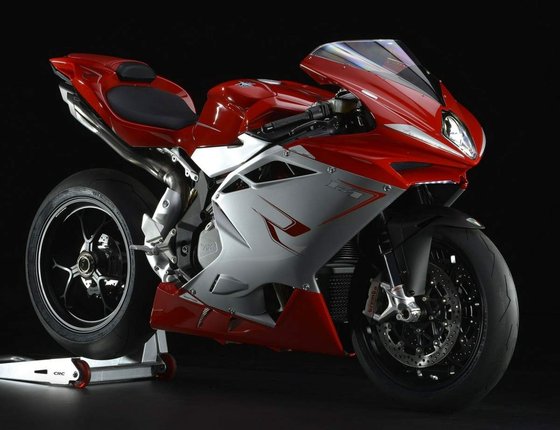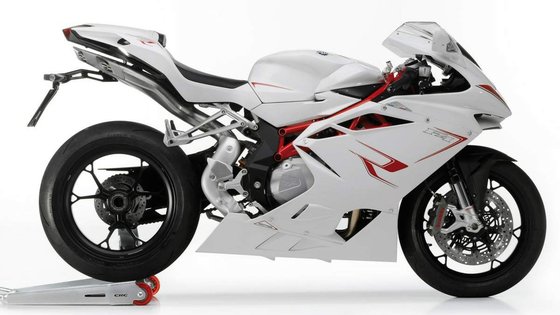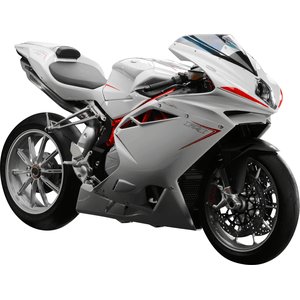MV Agusta F4 1000 (2013–2015): A Timeless Superbike Experience

Introduction
The MV Agusta F4 1000 isn’t just a motorcycle—it’s a statement. From its debut in the late ’90s, the F4 series has been synonymous with Italian artistry, razor-sharp performance, and a symphony of mechanical passion. The 2013–2015 iteration refines this legacy further, blending cutting-edge electronics with a chassis and engine that demand reverence. As a rider, straddling this machine feels like stepping into a tailored suit that’s been engineered for both the racetrack and the winding alpine roads of its homeland. Let’s dissect what makes this generation of the F4 1000 a masterpiece—and why it still turns heads (and wrenches hearts) today.
Engine: The Heart of a Legend
At the core of the F4 1000 lies a 998cc inline-four engine, a configuration that MV Agusta has perfected over decades. With 195 HP at 13,400 RPM and 110.8 Nm of torque at 9,600 RPM, this isn’t just power—it’s controlled fury. The engine’s short-stroke design (79mm bore x 50.9mm stroke) prioritizes high-revving aggression, rewarding riders who aren’t afraid to flirt with the redline.
Key Highlights:
- Radial Valves & Titanium Components: Borrowing tech from MotoGP, the radial valve system optimizes airflow, while titanium connecting rods (on the RR variant) reduce rotational mass, letting the engine spin freely to its 14,000 RPM limit.
- MVICS (Motor & Vehicle Integrated Control System): This Ride-by-Wire system offers four engine maps (Normal, Sport, Rain, Custom), allowing riders to tweak throttle response, torque delivery, and engine braking. Paired with 8-level traction control, it’s like having a racing engineer in your corner.
- Exhaust Note: The signature “organ pipe” exhaust isn’t just eye candy—it delivers a spine-tingling wail that crescendos into a mechanical opera at full tilt.
On the road, the F4 1000 feels alive. Below 6,000 RPM, it’s docile enough for city traffic, but crack the throttle open, and the world blurs. The surge from 9,000 RPM onward is addictive, launching you toward a claimed top speed of 291 km/h (180.9 mph). Yet, thanks to the slipper clutch and precise throttle mapping, even aggressive downshifts feel buttery smooth.
Chassis & Handling: Precision Meets Passion
The F4’s trellis frame—a mix of chromium-molybdenum steel tubes and aluminum alloy plates—is a work of structural art. It’s stiff, communicative, and weighs just 191 kg (421 lbs) dry, giving a power-to-weight ratio of 1.02 HP/kg.
Suspension & Brakes:
- Front: 50mm Marzocchi USD forks (fully adjustable for preload, compression, and rebound).
- Rear: Öhlins TTX monoshock (adjustable high/low-speed compression).
- Brakes: Dual 320mm Brembo M50 monobloc calipers up front, single 210mm Nissin disc at the rear.
The setup is track-focused but surprisingly forgiving on bumpy roads. At lean, the F4 carves corners with surgical precision, its 120/70-ZR17 front and 200/55-ZR17 rear tires offering immense grip. The steering is light yet direct, requiring minimal input to flick into hairpins. Meanwhile, the Brembos deliver stoppie-ready braking force, with ABS (optional on later models) adding confidence in wet conditions.
Design & Aesthetics: Rolling Art

MV Agusta’s design team treats motorcycles as canvases. The F4 1000’s bodywork is a study in aggression and elegance—sharp lines flow into muscular fuel tanks, while the quad-exit exhaust and single-sided swingarm scream exclusivity.
Standout Features:
- LED Light Guides: Integrated into the front spoiler and taillight, these elements enhance visibility while adding a futuristic flair.
- Forged Wheels: The 10-spoke design reduces unsprung weight and complements the bike’s mechanical brutality.
- Ergonomics: The 830mm (32.7-inch) seat height suits taller riders, but the rearset pegs and low clip-ons prioritize aerodynamics over comfort. This is a bike that rewards commitment.
Electronics: Beyond the Basics
The F4 1000 was ahead of its time electronically. Beyond traction control and engine maps, it features:
- EAS (Electronically Assisted Shift): Enables clutchless up/downshifts, perfect for track days.
- Inertial Platform: Gyroscopes and accelerometers adjust TC intervention based on lean angle, a rarity in pre-2015 bikes.
- Custom Map: Tweak throttle sensitivity, torque limits, and engine braking to your riding style.
In Rain mode, power is capped at 120 HP, softening throttle response to keep the rear tire in check. Switch to Sport, and the F4 transforms into a corner-exiting missile.
Competition: How Does the F4 1000 Stack Up?
The F4 1000’s rivals in the liter-bike segment include:
1. Yamaha YZF-R1 (2015):
- Pros: Crossplane crank for visceral torque, more affordable.
- Cons: Heavier (206 kg wet), less exotic.
- Verdict: The R1 is a better daily rider, but it lacks the F4’s exclusivity.
2. Aprilia RSV4 RF (2015):
- Pros: V4 engine character, advanced electronics.
- Cons: Complex maintenance, higher seat height (845mm).
- Verdict: The RSV4 is the F4’s closest rival in passion—but not in curb appeal.
3. Ducati 1299 Panigale:
- Pros: 1285cc V-twin torque, monocoque chassis.
- Cons: Overheating issues in traffic, polarizing design.
- Verdict: The Ducati is a brute; the MV is a scalpel.
The F4 1000 isn’t the fastest or most practical liter bike, but it’s arguably the most soulful. It’s for riders who value craftsmanship over lap times.
Maintenance: Keeping the Legend Alive

Owning an F4 1000 is a privilege—and a responsibility. Here’s what to prioritize:
1. Oil Changes:
- Use SAE 10W-60 fully synthetic oil (4.2L with filter). MV Agusta’s high-revving engine demands frequent changes—every 5,000 km (3,100 miles).
2. Valve Adjustments:
- Intake: 0.15–0.24mm (cold)
- Exhaust: 0.20–0.29mm (cold)
- Schedule checks every 12,000 km (7,500 miles).
3. Brake Fluid & Coolant:
- Replace DOT 4 fluid annually.
- Use water-based coolant mixed to 50% concentration.
4. Chain & Sprockets:
- The 15/40 sprocket combo favors acceleration. Keep the chain tension at 25–30mm slack and lubricate every 500 km.
5. Tire Pressures:
- Front: 2.3 BAR (33 PSI) / Rear: 2.3 BAR (33 PSI) for solo riding.
Pro Tip: Invest in a quality battery tender—the F4’s 12V 8.6Ah battery drains quickly during storage.
Conclusion: The Ultimate Italian Affair
The MV Agusta F4 1000 (2013–2015) isn’t just transportation—it’s a dialogue between rider and machine. From its wailing engine to its telepathic chassis, every component feels purpose-built to ignite passion. Yes, it’s demanding. Yes, it’ll cost you in maintenance. But for those willing to embrace its quirks, the F4 delivers an ownership experience no Japanese or German bike can match.
At MOTOPARTS.store, we understand that keeping such a masterpiece pristine requires premium components. Whether you’re upgrading to NGK CR9EIX iridium plugs or sourcing Brembo brake pads, we’ve got the parts to keep your F4 singing—and your heart racing.





Specifications sheet
| Engine | |
|---|---|
| Stroke: | Four-stroke |
| Max power: | 143 kW | 192.0 hp |
| Max torque: | 111 Nm |
| Fuel system: | Fuel Injection (Mikuni throttle body, Ride-By-Wire) |
| Max power @: | 13400 rpm |
| Displacement: | 998 ccm |
| Fuel control: | Double Overhead Cams (DOHC) |
| Max torque @: | 9600 rpm |
| Bore x stroke: | 79.0 x 50.9 mm (3.1 x 2.0 in) |
| Configuration: | Inline |
| Cooling system: | Liquid |
| Compression ratio: | 13.4:1 |
| Number of cylinders: | 4 |
| Valves per cylinder: | 4 |
| Dimensions | |
|---|---|
| Wheelbase: | 1430 mm (56.3 in) |
| Dry weight: | 191 |
| Seat height: | 830 mm (32.7 in) |
| Overall width: | 750 mm (29.5 in) |
| Overall length: | 2115 mm (83.3 in) |
| Ground clearance: | 115 mm (4.5 in) |
| Fuel tank capacity: | 17 L (4.5 US gal) |
| Drivetrain | |
|---|---|
| Final drive: | chain |
| Transmission: | 6-speed cassette-style, constant mesh |
| Rear sprocket: | 41 |
| Front sprocket: | 15 |
| Final drive ratio: | 15/41 |
| Primary drive ratio: | 48/82 |
| Electrical | |
|---|---|
| Battery: | 12V 8.6 Ah |
| Features: | MVICS (Motor & Vehicle Integrated Control System), Traction Control (8 levels), EAS (Electronically Assisted Shift) |
| Alternator: | 350W |
| Maintenance | |
|---|---|
| Engine oil: | 10W60 |
| Brake fluid: | DOT 4 |
| Spark plugs: | NGK CR9EB or NGK CR9EIX |
| Spark plug gap: | 0.7 |
| Coolant capacity: | 1.9 |
| Forks oil capacity: | 1.4 |
| Engine oil capacity: | 2.7 |
| Engine oil change interval: | Every 5000 km or annually |
| Valve clearance (intake, cold): | 0.15–0.24 mm |
| Valve clearance check interval: | 24,000 km (15,000 mi) |
| Valve clearance (exhaust, cold): | 0.20–0.29 mm |
| Recommended tire pressure (rear): | 2.3 bar (33 psi) solo / 2.9 bar (42 psi) with passenger |
| Recommended tire pressure (front): | 2.3 bar (33 psi) |
| Chassis and Suspension | |
|---|---|
| Frame: | CrMo Steel tubular trellis with aluminum alloy swingarm pivot plates |
| Trail: | 100.4 mm (3.93 in) |
| Rear tire: | 200/55 z-17 |
| Front tire: | 120/70 z-17 |
| Rear brakes: | 1 x 210 mm disc, Nissin 4-piston caliper (ABS optional) |
| Front brakes: | 2 x 320 mm discs, Brembo radial 4-piston calipers (ABS optional) |
| Rear suspension: | Öhlins TTX monoshock, adjustable rebound/compression damping and preload |
| Front suspension: | Marzocchi USD 50 mm telescopic fork, adjustable rebound-compression damping and preload |
| Rear wheel travel: | 120 mm (4.7 in) |
| Front wheel travel: | 120 mm (4.7 in) |



















